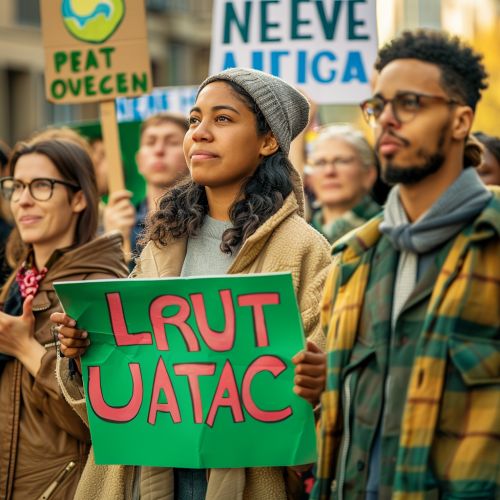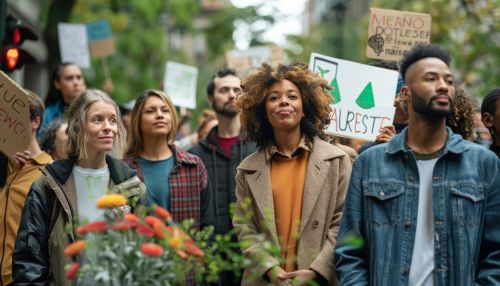Climate Justice: Difference between revisions
(Created page with "== Introduction == Climate justice is a term that encapsulates the ethical and political dimensions of climate change. It emphasizes the need to address the disproportionate impacts of climate change on marginalized and vulnerable communities. The concept extends beyond the scientific and environmental aspects of climate change, incorporating human rights, social equity, and environmental justice. This article delves into the multifaceted nature of climate justice, expl...") |
No edit summary |
||
| Line 43: | Line 43: | ||
Rising sea levels, extreme weather events, and environmental degradation force communities to migrate, leading to [[climate refugees]]. Small island nations and coastal regions are particularly vulnerable to displacement. This phenomenon poses significant challenges for host communities and international legal frameworks, which currently lack comprehensive protections for climate-induced displacement. | Rising sea levels, extreme weather events, and environmental degradation force communities to migrate, leading to [[climate refugees]]. Small island nations and coastal regions are particularly vulnerable to displacement. This phenomenon poses significant challenges for host communities and international legal frameworks, which currently lack comprehensive protections for climate-induced displacement. | ||
[[Image:Detail-92135.jpg|thumb|center|A diverse group of people holding signs advocating for climate justice at a peaceful protest.|class=only_on_mobile]] | |||
[[Image:Detail-92136.jpg|thumb|center|A diverse group of people holding signs advocating for climate justice at a peaceful protest.|class=only_on_desktop]] | |||
== Legal and Policy Frameworks == | == Legal and Policy Frameworks == | ||
Latest revision as of 01:21, 18 June 2024
Introduction
Climate justice is a term that encapsulates the ethical and political dimensions of climate change. It emphasizes the need to address the disproportionate impacts of climate change on marginalized and vulnerable communities. The concept extends beyond the scientific and environmental aspects of climate change, incorporating human rights, social equity, and environmental justice. This article delves into the multifaceted nature of climate justice, exploring its origins, principles, and implications for policy and action.
Historical Context
The roots of climate justice can be traced back to the broader environmental justice movement that emerged in the United States during the 1980s. This movement highlighted the unequal distribution of environmental hazards and benefits, particularly affecting low-income and minority communities. The United Nations Framework Convention on Climate Change (UNFCCC), established in 1992, marked a significant milestone in the global recognition of climate change as a critical issue. However, it was not until the early 2000s that the term "climate justice" gained prominence, driven by advocacy from non-governmental organizations (NGOs) and grassroots movements.
Principles of Climate Justice
Climate justice is grounded in several core principles:
Equity
Equity in climate justice refers to the fair distribution of the burdens and benefits of climate action. This principle recognizes that those who have contributed least to climate change, such as developing countries and marginalized communities, often suffer the most from its impacts. Equity calls for differentiated responsibilities, where wealthier nations and high-emission industries bear a greater share of the mitigation and adaptation efforts.
Human Rights
The human rights dimension of climate justice emphasizes the protection and promotion of fundamental rights, including the right to life, health, and an adequate standard of living. Climate change poses significant threats to these rights, particularly for vulnerable populations such as indigenous peoples, women, and children. Ensuring that climate policies respect and uphold human rights is a cornerstone of climate justice.
Participation
Meaningful participation of affected communities in climate decision-making processes is essential for achieving climate justice. This principle advocates for inclusive and transparent mechanisms that empower marginalized groups to have a voice in shaping climate policies and actions. Participation fosters accountability and ensures that solutions are culturally appropriate and context-specific.
Intergenerational Justice
Intergenerational justice addresses the ethical obligation to protect the environment for future generations. It underscores the need for sustainable development practices that do not compromise the ability of future generations to meet their needs. This principle challenges short-term, profit-driven approaches and advocates for long-term, holistic strategies to combat climate change.
Impacts of Climate Change on Vulnerable Communities
Climate change exacerbates existing social, economic, and environmental inequalities. Vulnerable communities, including indigenous peoples, small island nations, and low-income populations, face disproportionate risks and challenges. These impacts manifest in various forms:
Health
Climate change affects public health through increased incidence of heatwaves, respiratory diseases, and vector-borne illnesses. Vulnerable populations often lack access to adequate healthcare and are more susceptible to these health threats. For example, malaria and dengue fever are expected to spread to new regions as temperatures rise.
Livelihoods
Agricultural communities, particularly in developing countries, are highly dependent on stable climatic conditions. Climate change disrupts agricultural productivity through altered precipitation patterns, extreme weather events, and soil degradation. This threatens food security and exacerbates poverty, particularly for smallholder farmers and rural communities.
Displacement
Rising sea levels, extreme weather events, and environmental degradation force communities to migrate, leading to climate refugees. Small island nations and coastal regions are particularly vulnerable to displacement. This phenomenon poses significant challenges for host communities and international legal frameworks, which currently lack comprehensive protections for climate-induced displacement.


Legal and Policy Frameworks
Addressing climate justice requires robust legal and policy frameworks at international, national, and local levels. Several key instruments and agreements have been established to promote climate justice:
International Agreements
The Paris Agreement, adopted in 2015, is a landmark international treaty that aims to limit global warming to well below 2°C above pre-industrial levels. It emphasizes the principles of equity and common but differentiated responsibilities, recognizing the need for developed countries to support developing nations in their climate efforts.
The Kyoto Protocol, an earlier international treaty, set binding emission reduction targets for developed countries. While it laid the groundwork for international climate action, it faced criticism for its limited scope and lack of enforcement mechanisms.
National Policies
Countries have implemented various national policies to address climate justice. For instance, India's National Action Plan on Climate Change (NAPCC) includes missions focused on sustainable agriculture, water conservation, and protecting vulnerable ecosystems. Similarly, South Africa's National Climate Change Response Policy emphasizes the need to address social and economic inequalities in climate action.
Local Initiatives
Local governments and communities play a crucial role in advancing climate justice. Initiatives such as community-based adaptation projects and participatory planning processes empower local populations to develop context-specific solutions. For example, the Green Belt Movement in Kenya, founded by Wangari Maathai, focuses on tree planting and environmental conservation to enhance community resilience.
Climate Justice Movements and Advocacy
Grassroots movements and NGOs have been instrumental in advancing climate justice. These organizations advocate for systemic change, mobilize communities, and hold governments and corporations accountable. Notable movements include:
Fridays for Future
Founded by Greta Thunberg, Fridays for Future is a global youth-led movement that demands urgent climate action. The movement emphasizes the need for intergenerational justice and highlights the disproportionate impacts of climate change on young people.
Extinction Rebellion
Extinction Rebellion (XR) is a decentralized, non-violent movement that uses civil disobedience to demand radical action on the climate crisis. XR advocates for climate justice by highlighting the interconnectedness of social and environmental issues.
Indigenous Environmental Network
The Indigenous Environmental Network (IEN) is a coalition of indigenous peoples advocating for environmental and climate justice. IEN emphasizes the importance of traditional knowledge and the rights of indigenous communities in climate action.
Challenges and Criticisms
While climate justice has gained significant traction, it faces several challenges and criticisms:
Implementation Gaps
Despite international agreements and national policies, there are significant gaps in the implementation of climate justice principles. Lack of political will, inadequate funding, and bureaucratic hurdles often hinder effective action.
Market-Based Mechanisms
Market-based mechanisms, such as carbon trading and offset schemes, are often criticized for failing to address the root causes of climate change and perpetuating inequalities. Critics argue that these mechanisms allow high-emission industries to continue polluting while placing the burden on vulnerable communities.
Technological Solutions
Technological solutions, such as geoengineering and carbon capture and storage (CCS), are often proposed as ways to mitigate climate change. However, these approaches raise ethical concerns and may have unintended consequences on ecosystems and communities.
Future Directions
Achieving climate justice requires a multifaceted approach that integrates social, economic, and environmental dimensions. Future directions include:
Strengthening Legal Frameworks
Enhancing international and national legal frameworks to protect the rights of vulnerable communities is essential. This includes recognizing the legal status of climate refugees and ensuring accountability for human rights violations related to climate change.
Promoting Just Transitions
A just transition involves shifting to a low-carbon economy in a way that ensures social equity and protects workers' rights. This includes investing in green jobs, providing retraining programs, and supporting communities dependent on fossil fuel industries.
Enhancing Climate Finance
Increasing financial support for developing countries to implement mitigation and adaptation measures is crucial. This includes fulfilling commitments under the Paris Agreement and ensuring that climate finance reaches the most vulnerable communities.
Conclusion
Climate justice is a vital framework for addressing the complex and interconnected challenges posed by climate change. By prioritizing equity, human rights, participation, and intergenerational justice, climate justice advocates for a fair and inclusive approach to climate action. As the impacts of climate change continue to intensify, the principles of climate justice will play an increasingly critical role in shaping global, national, and local responses.
